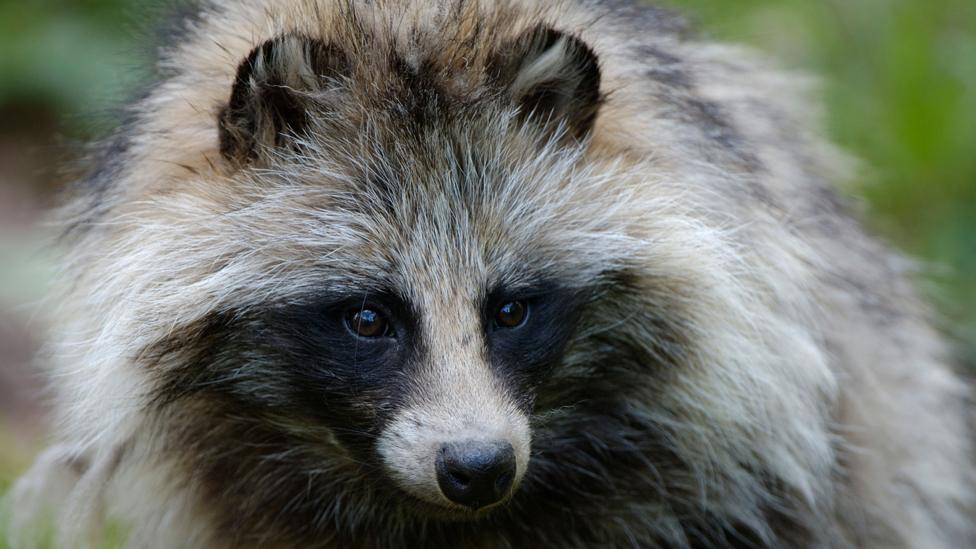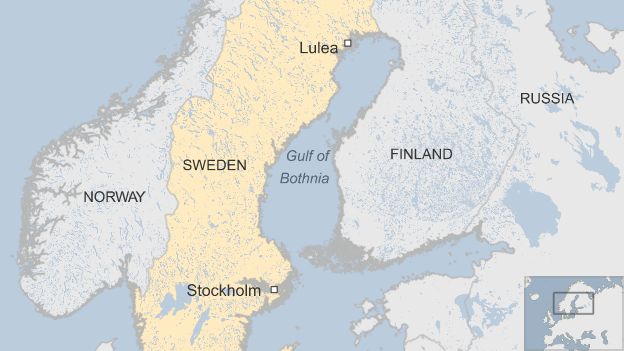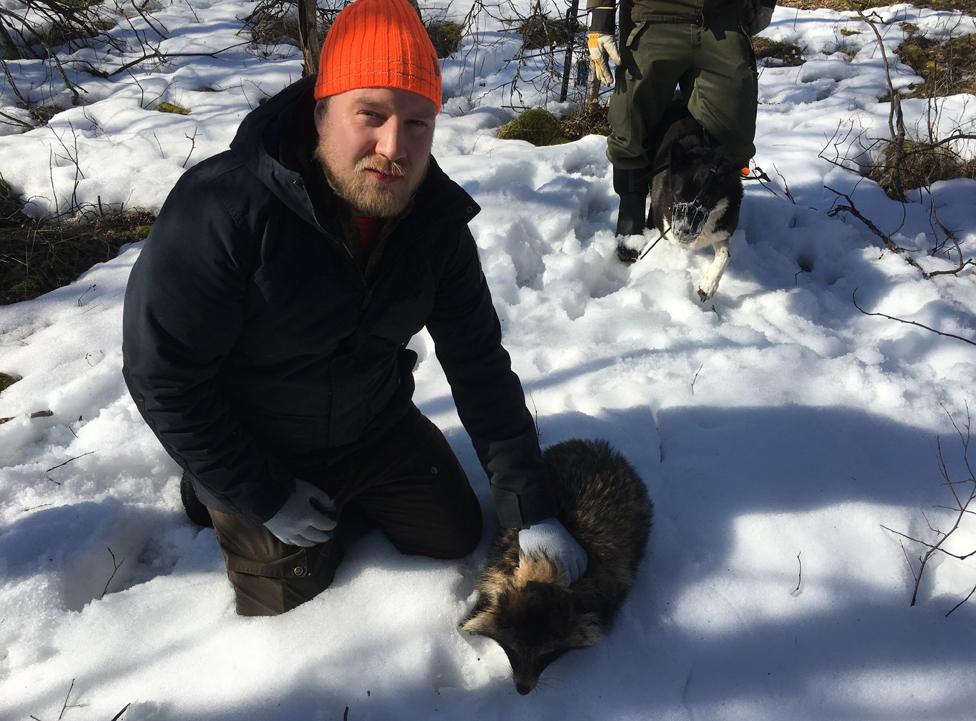The cute creature Sweden wants to wipe out
- Published

They look cute and cuddly and are sometimes kept as pets - but raccoon dogs are a menace, threatening wildlife across Europe. Sweden is so worried about their impact that it has trained a team to hunt and kill the animals, with the unwitting help of creatures made to betray their mates.
It's mid-April and on the Gulf of Bothnia between Sweden and Finland, the ice covering the sea is still a metre thick.
It's where Ludde Noren and Viktor Medstrom, two professional hunters from the Swedish Association for Hunting and Wildlife Management have switched off their snowmobiles and are using GPS tracking equipment to try to detect signals of an unwelcome visitor.
The animal they are looking for is a raccoon dog, a fox-like creature native to East Asia that has a similar face to a raccoon but is a member of the canine family.
The beeps coming from the tracking equipment are weak, so it's back on the snowmobiles to roar across the vast expanse of the frozen sea towards a small island.

Ludde Noren (left) and Per-Arne Ahlen hunting raccoon dogs
Per-Arne Ahlen who leads Sweden's project to eradicate raccoon dogs, is with them too. He says the animals were first released in the European parts of the former Soviet Union by biologists as a source of fur.
"Economic success 80 years ago, today an ecological disaster," he says.
An ecological disaster, he explains, because raccoon dogs feed on amphibians and ground-nesting birds in wetland areas.
"Amphibian species can go extinct in areas with a high raccoon dog population," Ahlen says.
Along with the Arctic fox, they reproduce more quickly than any other canine species. A million are born every year in Finland, and there are thousands more in Germany. They have been sighted as far west as France and the Netherlands, Ahlen says.

Find out more
Keith Moore's report can be heard on PM, 17:00 BST on BBC Radio 4, Saturday 7 May

Sweden's plan to eradicate raccoon dogs began a decade ago, when they were first spotted in the far north of the country - now the animals are hunted to reduce the threat to biodiversity.
Some of the work is done from an office in Lulea, a city 900km (560 miles) north of the capital Stockholm. The staff there receive thousands of sightings from members of the public every year, which are then followed up by field staff.
There are also cameras on the main routes between Sweden and Finland which can detect raccoon dogs as they arrive in the country.

And from their computers they are able to track the so-called "Judas animals".
These are raccoon dogs that have been caught, sterilised, tagged and released.
Raccoon dogs stay with a partner for life and as soon as the Judas dogs are released, they go in search of a new partner.
When one stops moving, the office dispatches one of the six full-time field workers to see if it has found a new partner.
Two hours north-east of the office, Noren and Medstrom, the two men on the snowmobiles, have tracked one of the Judas animals to a small uninhabited island still covered in snow.
Their tracking equipment now beeps at shorter intervals.
"You hear, the signal is more frequent, it's a moving signal," says Noren. He's helped by his hunting dog, which can help sniff out the raccoon dog but is muzzled so it can't do any harm.
There are paw prints in the snow. It's hard to tell whether it's from one raccoon dog or two.
Noren tells everyone to stop. There's fur poking out from behind a tree.
Are raccoon dogs aggressive animals?
"I'm used to comparing it to a badger on sleeping pills," Noren says.

Ludde Noren with a trapped raccoon dog
Project leader Ahlen takes the lead and hooks the raccoon dog with a snare. It barely moves.
It is alone and hasn't managed to find a partner for the team to shoot.
So it is weighed and released.
The system hasn't worked on this occasion but Ahlen is convinced of its effectiveness.
"I stole it from the Spanish and Ecuadorian governments, their way of eradicating goats on Galapagos," he says. "[They] didn't succeed until they started with the Judas goats."
Ahlen says it's a technique being used a lot now in conservation biology to eradicate invasive species. There are Judas rats in Mexico, Judas pigs in North America and Judas camels in Australia.
At one time, there were between 100-130 raccoon dogs in Sweden, Ahlen says. But in the past 10 years they have killed about 2,000 in Sweden and on the bordering areas of Finland and they're now finding and killing fewer and fewer.

The raccoon dog (Nyctereutes procyonoides)
Sweden has a relatively small population of raccoon dogs - now probably fewer than 100, says Ahlen. He estimates there are up to 1,000 in Denmark and hundreds of thousands in Germany and Poland. In Finland the population is rising and in spring is approximately 250,000 - although about a million cubs are born each year, most die from starvation, hunting and road accidents. In Norway, there are "hopefully zero - we try to keep it that way". In France a few sightings and some road kills have been reported. The creatures could soon establish themselves in the wild both there and in the UK where escaped pets pose a potential problem, he says.

It's illegal to keep them as pets in Sweden, Denmark and Norway but Ahlen says he has seen evidence that people in the UK do have them as pets.
"The thing if you have them as pets is that they will escape and then you will endanger your native fauna if you release them in England," he says.
"Both from Ireland and the UK, I've seen several cases where people have lost their pets and I'm quite sure that if you have not already, I think that you will have your first feral emerging population by reproduction of escaped pets."
Ahlen says the project to eradicate raccoon dogs in Sweden hasn't faced any opposition.
"Not even the animal rights groups are against what we're doing because we are protecting our grandchildren's nature, we are protecting the animals that will disappear if we have raccoon dogs in southern Sweden," he says.
"Conservation biology is not always nice, it's not beautiful all the time."
Subscribe to the BBC News Magazine's email newsletter to get articles sent to your inbox.